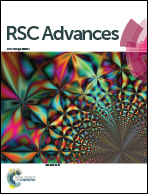Electrically tunable, plasmon resonance enhanced, terahertz third harmonic generation via graphene†
Abstract
In this study, we demonstrate how field enhancement due to plasmonic resonances can noticeably improve the efficiency of third harmonic generation (THG) from graphene sheets on a grating substrate under normal illumination of terahertz (THz) waves. We explore how different parameters of graphene and the substrate can affect the strength of the resonance and, thus, the third harmonic (TH) level. Interestingly, we show that the gate voltage tunability of the linear and nonlinear conductivities of graphene and, thus, the resonant frequency of the structure, enable the achievement and control of the plasmonic resonance enhanced THG over the THz frequency band. Based on our finite difference time domain (FDTD) numerical simulations, we reveal that a more than 5 orders of magnitude improvement in the TH level would be achievable by placing high quality graphene samples on a grating substrate under resonant conditions instead of placing them on a flat substrate. We hope that these findings can pave the way for the development of a plethora of valuable applications in the THz frequency band, such as generating new frequencies, spectroscopy, and signal processing.


 Please wait while we load your content...
Please wait while we load your content...